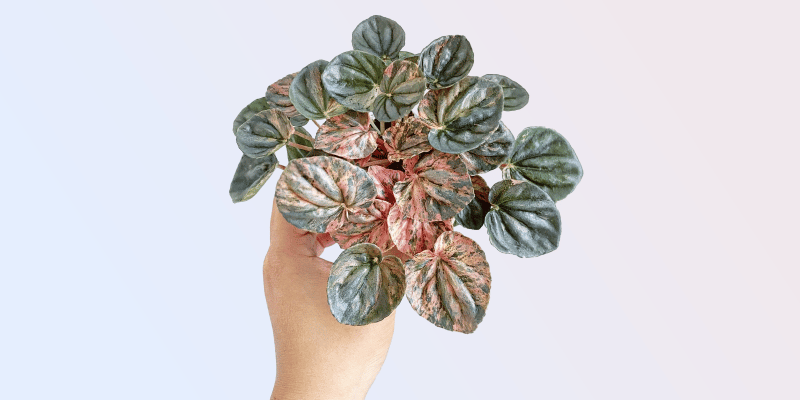Ah, Peperomia caperata, the succulent that’s not a succulent, the plant that can withstand anything . . . okay, almost anything.
Super adaptable with seriously low maintenance demands, Peperomia caperata has rippled leaves that come in an array of attractive varieties and colors. This tropical plant has a wavy texture, grows pretty compactly, and can live in lower light, so it’s ideal for a home or office environment.
Peperomia caperata care couldn’t be easier, and I mean that. Let’s find out just how simple it is to keep this adorably ruffled plant thriving!
Table of Contents
Peperomia Caperata Care Guide
History, habitat, and characteristics
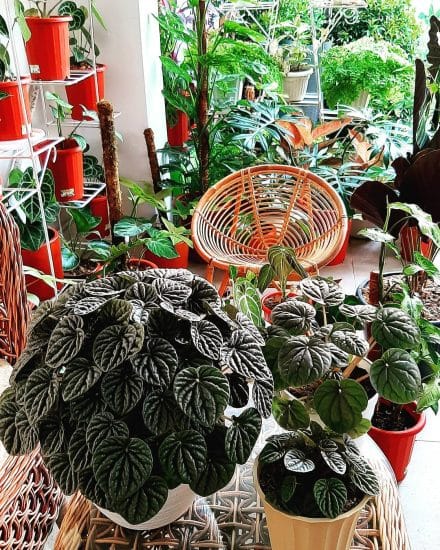
Peperomia caperata, also known as ‘Emerald Ripple’ Peperomia, ‘Green Ripple’ Peperomia, ‘Little Fantasy’ Peperomia, or radiator plant (what a mouthful!), is an evergreen epiphyte native to the steamy jungles of southeastern Brazil.
It was apparently a well-kept secret from the scientific literature — Europeans and Americans both knew about this plant for years before Truman G. Yuncker, Piperaceae botanist extraordinaire, first officially described it in 1958. About time!
(Peperomia caperata are part of the Piperaceae family — they resemble and are related to black pepper, or Piper nigrum, also in the Peperomia genus.)
Peperomia is derived from the Latin peperi (“pepper”) and homiois (“resembling”) literally translating to “pepper-like”, while caperata means “rippled”. And rippled these leaves are!
Peperomia caperata’s heart-shaped, waxy dark green leaves have signature wrinkles that almost look corrugated. Red-tinged stems tower over them, supporting two to three-inch whitish-green flower spikes in the summertime.
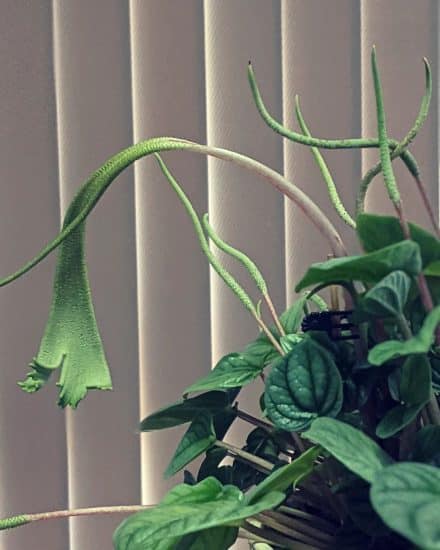
The plant itself reaches up to 8 inches tall and wide. “Ripple peperomia” is an epiphyte, meaning it grows supported by other plants, like the trees in the South American rainforests of its native habitat.
Let’s talk about varieties.
Peperomia Caperata Varieties
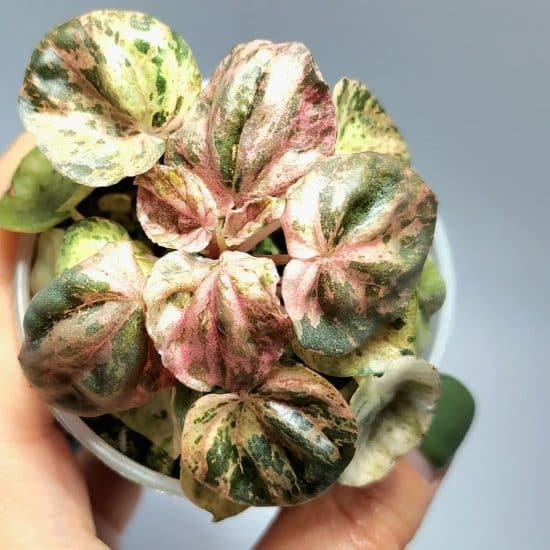
The world is flooded with fascinating ripple plant cultivars, and more are produced all the time. Here is a list of some of the most popular. Note that many of these look alike except for their color.
- Peperomia caperata ‘Luna Red’ – heart-shaped, dark purple and crimson leaves
- Peperomia caperata ‘Lilian’ – resembles ‘Emerald Ripple’ but with crested blooms
- Peperomia caperata ‘Burgundy Ripple’ – dark magenta leaves
- Peperomia caperata ‘Silver Ripple’ – light green silvery leaves
- Peperomia caperata ‘Rosso’ – when young, leaves have red undersides and veins with reddish stalks; as they mature, leaves turn heart-shaped and dark green
- Peperomia caperata ‘Lemon’ – Same as the original but with yellow leaves
- Peperomia caperata ‘Luna’ – Again, the same as its namesake but with gray leaves
- Peperomia caperata ‘Quito’ – also known as ‘Orange Ripple’; vibrant orange, bronze, and pink leaves
- Peperomia caperata ‘Suzanne’ – deep ridges and silver-accented leaves
- Peperomia caperata ‘Variegata’ – may also be called ‘Helios’; leaves with cream, pink, and green splashes, plus pink stems
Peperomia caperata ‘Pink Lady’, ‘White Lady’, and ‘Jolien’ are also variegated. And they keep on coming!
Eden Collection in the Netherlands was granted four Peperomia caperata cultivar patents in 2022 alone, developed by plant hunter Obed Smit. They don’t appear to have descriptive names as of this writing, but:
- ‘EC-PEPE-2101’ has bluish-grey leaves with deep veins.
- ‘EC-PEPE-2111′ has dark green leaves with red veins on their down surface.
My planty senses are tingling . . . Keep an eye out, and let us know if you think you’ve come across one!
Now that you have the inside scoop on the newest Peperomia caperatas cultivars to hit the market, let’s go over their ideal growing environment indoors.
Light
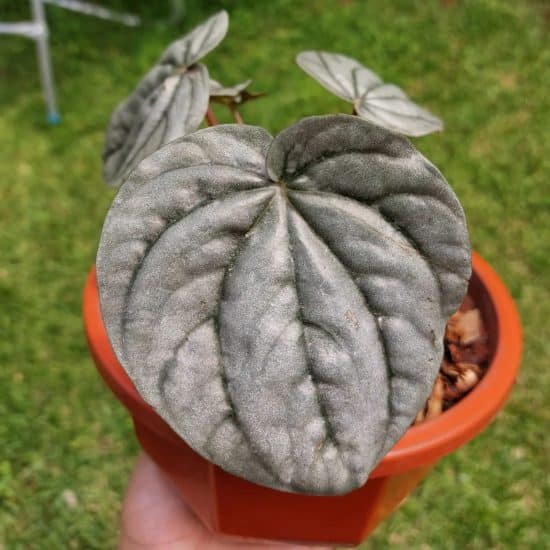
Peperomia caperata thrives in bright indirect sunlight. But . . . one of the reasons this plant is so easy to grow? It does just fine in lower light, too.
That being said, optimal lighting for your plant is near a north or east-facing window. For south or west-facing exposures, keep your Peperomia at least 3 to 5 feet back, and filter direct sunlight with a sheer curtain during peak hours. If your home doesn’t get enough natural light, artificial lighting — LED or fluorescent lights — can help.
Speaking of not getting enough light, you may notice your plant getting “leggy” as it reaches for more sun, or paler leaves. Variegated cultivars might lose their vibrant colors and turn solid green. On the other hand, if the light is too intense, your Peperomia caperata’s leaves may start to brown.
Dust can also block your plant from photosynthesizing, so you can routinely wipe off any dust you see with a slightly damp cloth.
Water
To keep your Peperomia happy, you need to find the sweet spot between “too much” and “not enough,” or the amount and frequency of water that works best for it.
Tip: Stick your finger in the soil, and if the top 2-3 inches of soil feel dry, it’s time to water.
Peperomia caperata plants are unique in that their leaves and stems are succulent-like and can store water. This means they don’t require water as often as other houseplants.
Observe your plant’s leaves for clues about how to get the watering level just right. Drooping or browning leaves likely mean the plant needs more water stat, while drooping and yellowing leaves could mean excess water is the problem here.
This plant does require a bit more water in the growing months. Generally, water once a week during spring and summer, and once every two weeks during fall and winter.
When you do, try to use room-temperature water so you don’t shock your plant baby.
Temperature and humidity
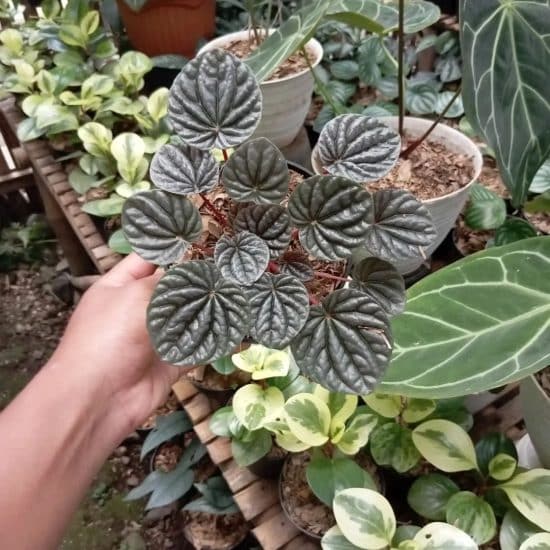
Both temperature and humidity are essential to Peperomia caperata care, and they often go hand in hand. While these are resilient plants, once you hit that sweet spot you’ll notice vibrant growth and an improved overall appearance.
For temperature you’ll want to aim for 60-85°F. They really won’t tolerate anything below 50°F well, and honestly… neither will you! Higher temps than that can cause wilting. Lower temperatures can cause brown leaf tips.
Tip: According to research in the journal Scientia Horticulturae, higher temperatures are better for Peperomia caperata inflorescences (flowers). You’ll get twice as many flowers at 70°F than at 59°F!
When it comes to humidity, you don’t have to pity the poor Peperomia unless your home has really low humidity levels, in which case, you’d also likely be shriveling. To avoid that outcome, keep the humidity at moderate household levels of 30 to 50%. Your plant can adjust to slightly lower or higher, though.
If you and your “Emerald ripple plant” need more humidity, don’t mist its leaves without wiping them down afterward. This doesn’t raise humidity long-term and tends to attract diseases and pests you’d rather not have around.
Instead, grab a humidifier, cluster your plants together so they can share moisture, or create a pebble tray filled with water and put your plant on top. Consider snagging a hygrometer to more accurately keep track of your plant’s humidity level. You should be all set!
Soil and planting
Peperomia caperata needs a well-draining soil mix (slightly acidic, around 6.0 – 6.5 pH) that also holds the right amount of moisture. A regular succulent mix will suffice, or a houseplant mix with a handful of coco coir and perlite thrown in. As long as it keeps your plant’s root aerated and slightly moist, and gives them nutrients, the potting ingredient combo will do just fine.
Pruning
This is a slow-growing plant that doesn’t need much pruning unless you want to give it a bushier look. If so, always use sterilized shears or scissors and cut the stem at a 45° angle. Feel free to pinch dead leaves off with your fingers.
Repotting
Although Peperomia doesn’t need to be repotted often, when it does, spring is the best time, since your plant will be actively growing and less stressed. Pick a container only one or two inches larger than the one it’s currently in, with at least one or two drainage holes.
Avoid packing the soil too tightly around the root ball, since this could inhibit oxygen flow to the roots and cause them to rot.
Fertilizing
Use a balanced fertilizer (20-20-20, say) diluted to half strength every two weeks during the growing season. In winter, your plant will be dormant and won’t need to be fertilized at all. In fact, fertilizer could do more harm than good at that time.
Peperomia caperata ideal environment? Check. Peperomia propagation? Couldn’t be more simple. Let’s dive in!
Propagation guide
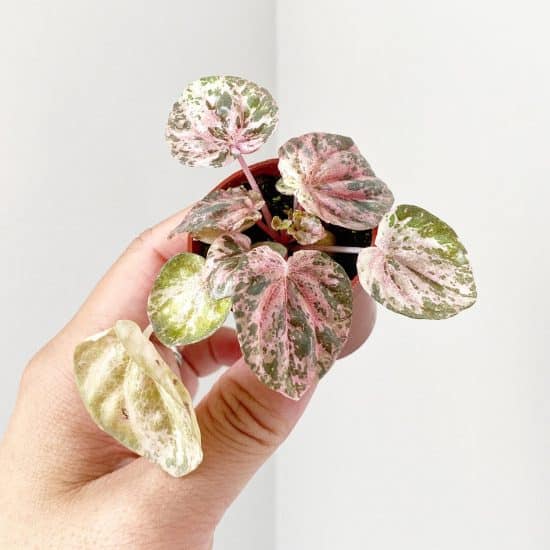
Stem and leaf tip cuttings are the way to go here. We’ll go over the stem-cutting propagation method.
Propagating stems in water lets you watch root growth progress, which can be pretty fun. The alternative would be to root in soil instead, which can sometimes produce stronger roots from the start.
This is a matter of personal preference, so experiment!
(Tip: Use leaf cuttings for solid varieties with variegation. Stem cuttings are the preferred choice for variegated peperomia, since they’ll have a better chance of ensuring the new plant retains those same variegated colors you know and love.)
To propagate peperomia caperata by stem cuttings:
- Use sterilized pruning shears or scissors to cut a stem at least four inches long with two or three leaves. Remove any bottom leaves.
- Place the cutting into a jar of water, making sure no leaves are submerged.
- Place the jar somewhere it will receive bright indirect sunlight.
- Change the every few days to keep it fresh.
- You’ll see roots start growing in a few weeks. After a few inches grow, plant the cutting in a pot filled with succulent soil mix. Think moist but not soggy soil.
- When you see new growth, congratulations, you can take care of your cutting like the new peperomia caperata it is!
You’ll have a beautiful collection of peperomia caperata before you know it. Now let’s learn how to deal with any common issues that might crop up.
Common issues
The most common issues we see with Peperomia caperata are usually from too much water or issues with where a plant is placed (light levels).
Water Issues
Peperomia caperata is especially sensitive to overwatering. Look out for damp soil that remains wet or wilting, and yellow leaves.
To prevent this: water when soil is dry two or three inches down, and reduce how often you water during the winter.
Not giving your plants enough water? They’ll wilt and might turn brown and crispy. The same thing will happen if they’re having . . .
Light Issues
Too much light: you’ll see curling, crispy, faded brown leaves. Move the plant farther back from a window and use a curtain to diffuse direct sunlight.
Not enough light: your plant will droop, turn pale then yellow, and soon stretch out toward the sun as its stems grow leggy. Variegated plants will often lose their coloring and turn a solid green.
Solution: Move your plant closer to a window, augment with LED grow lights, or open up those curtains.
Nutrient Deficiency
Nutrient deficiency occurs when Peperomia caperata isn’t getting certain minerals and nutrients it needs to stay healthy. Symptoms include yellowing leaves, pale or stunted growth, and dark green veins. This is usually due to an imbalanced fertilizer or potting mix.
Use a balanced NPK fertilizer twice a month in the growing season. Also, make sure your potting mix has enough nutrients. You can add compost or organic matter like worm castings to boost its nutrient level, or even a slow-release compost blend. Bonus: this also supports strong leaf color (great for those variants!).
Diseases and pests
There are three common things to watch out for: root rot, fungus, and bugs.
Root Rot
Almost all plants can suffer from root rot, and Peperomia caperata is unfortunately not an exception. The typical cause is overwatering or a slow draining soil. If you notice yellowing and wilting leaves, along with brown spots, check the roots and make sure they feel firm.
The fix: cut off any roots that look squishy and black, then repot in fresh, well-aerated soil. Make sure to let the soil dry thoroughly dry out between each watering.
Fungus
Fungus on your plant will usually look like brownish or black spots, sometimes with a colorful border. You’ll notice it spread over time in tiny irregular circular shapes. As these circles spread, they’ll often merge and create a new, larger circle. If this is what you see: 100% fungus.
Fungus is most often an issue with Peperomia caperata plants when they’re overwatered, or in a room with poor air circulation and high humidity. If you see fungus symptoms, isolate the plant, remove the affected leaves, and treat it with a fungicide right away.
Bugs
Though peperomia caperata plants are fairly pest-resistant, unwanted guests like mealybugs, aphids, thrips, and spider mites may still cause damage. Check the underside of leaves and around the stems for small white bugs or webbing.
If you notice bugs: isolate the plant from your other plants and treat it with soapy water or diluted neem oil.
Conclusion
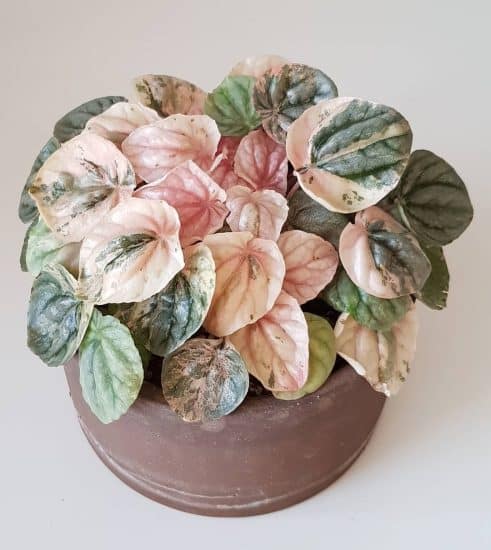
A hardy, versatile plant, Peperomia caperata also comes in stunning varieties. Bright light? Low light? Cold temperatures? Peperomia caperata will thrive (as long as conditions aren’t too extreme, of course!).
This plant is easy to propagate through stem or leaf cuttings, and its textured leaves will bring anything, from a living room to a work desk, added dimension and beauty.
Depending on which of the Peperomia varieties you have, get ready for loads of beautiful foliage and plenty of vibrant coloring in the future!
If you enjoyed this article, share it with a friend. And be sure to let us know what cultivar you choose!
FAQ
Does Peperomia need sunlight?
Yes, Peperomia caperata need bright, indirect light to thrive, but they can survive in less of it than certain other household plants. They’re very versatile!
How often should I water my Peperomia caperata?
This will depend on your home or office’s temperature, humidity, and a host of other factors. The best bet is to water when the soil is barely moist or dry two to three inches down.
Is Peperomia caperata a good indoor plant?
It’s better than that — Peperomia are excellent indoor plants! As slow-growing, compact plants, they don’t require much upkeep and fit in small spaces. A win-win!
Is Peperomia caperata a succulent?
While this plant has succulent-like leaves that can store water, it isn’t a true succulent. Why not? Ultimately, Peperomia caperata isn’t from the same family, and requires more moisture and humidity than the typical succulent.
Is Peperomia caperata toxic to dogs?
According to the ASPCA, all Peperomia, including Peperomia caperata, are not toxic to cats or dogs, so it’s safe to keep them around your furry buddies.
Sources
- https://plants.ces.ncsu.edu/plants/peperomia-caperata/
- https://www.rhs.org.uk/plants/20612/peperomia-caperata-luna-red/details
- https://www.sciencedirect.com/science/article/abs/pii/0304423890900083
- https://www.aspca.org/pet-care/animal-poison-control/toxic-and-non-toxic-plants/emerald-ripple-peperomia

